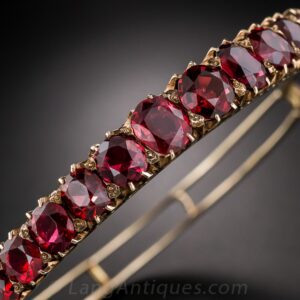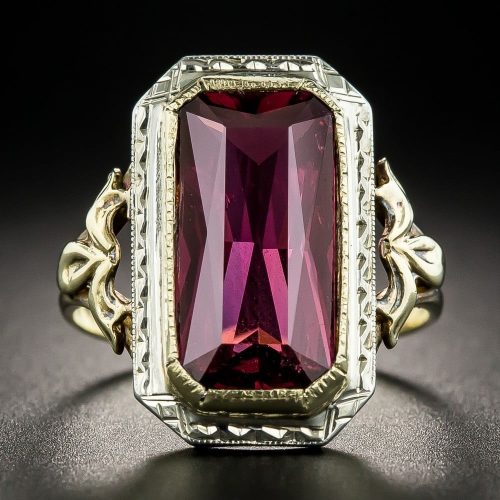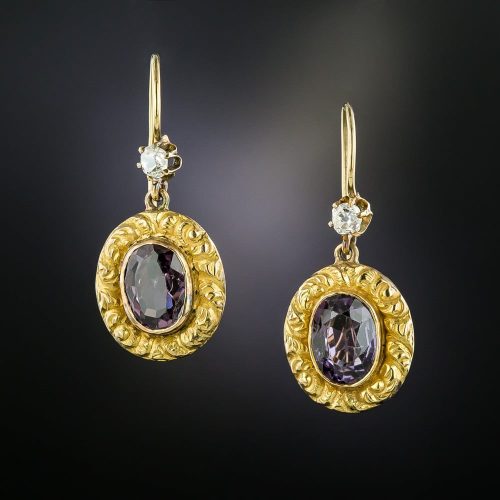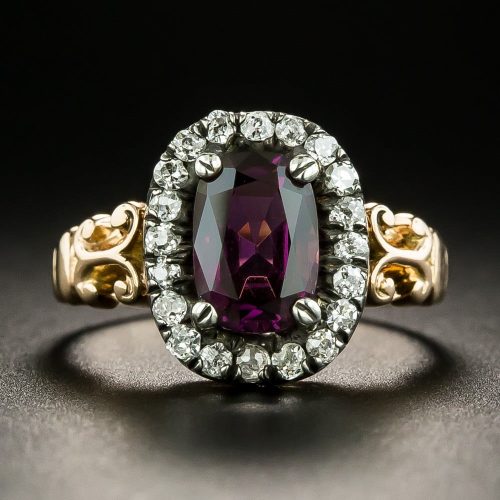
Spinel is a magnesium aluminum oxide, occurring in many colors with excellent durability. Natural spinel is really a group of related minerals in which its magnesium is substituted with other elements, like iron, manganese and zinc. Spinel is found in areas that are famous for sapphire deposits. For many centuries, most gem spinels were misidentified as sapphires or rubies because they have similar properties and occur in the same geological environments.
Like diamond and fluorite, spinel crystals can form perfect octahedrons. Occasionally, spinels can contain fine-oriented needles producing star stones when cut en cabochon.
Synthetic spinels have been available since 1920. The process of making them synthetically was discovered by accident when chemists were attempting to create better synthetic sapphires. Synthetic spinels can be made in several different colors, but the most common use of synthetic spinel today is to imitate aquamarine in birthstone jewelry.
A Brief History of Spinel
The earliest red spinels, used as jewels were found in Buddhist tombs in Kabul Afghanistan, and date back to approximately 100 B.C. Red spinels were also frequently used by the ancient Romans as early as the first century B.C. The Romans brought examples of blue and green spinel into England, during their occupation, which dates back to 51 B.C.
The actual mining of spinel began in Afghanistan between 750 and 950 A.D., documented by Marco Polo.
Red spinels have always been favored and have the most dramatic history. In Moscow, a 412.25 carat dark red spinel is the centerpiece for the Great Imperial Crown commissioned for the coronation of Catherine the Great. Red spinels were used frequently in the Renaissance and became quite fashionable in the 18th Century. The largest collection of spinels, which includes a 500-carat gem, is part of the collection of the Royal Crown Jewels of Iran.
Spinel is a mineral group that produces some of the finest gemstones, yet it has never been accepted by the general public as a valuable adornment due to poor marketing. It has a hardness that is equal to topaz and is very durable. Historically all red gemstones were termed “ruby” – or carbunculus – and the 170 ct red stone in the British Imperial State Crown has always been referred to as the “Black Prince’s Ruby”, while only in recent history it has been identified as a red spinel.



In antique jewelry, one will hardly ever encounter spinel although the jewelers from days gone by may have used them as rubies or sapphires. It was in the second half of the 18th century that the distinction between spinel and ruby was made and the demand for these former “oriental rubies” declined, as did the price, in favor of “real” rubies. One will for that reason not find many spinels in antique jewelry from the Georgian period hitherto (although spinel is gaining in popularity in present times).
The different optical and physical properties should pose little problems for an experienced gemologist to distinguish between them.
Historically spinel has been mined in Myanmar (Mogok) and Tajikistan. Newer deposits of importance are in Tanzania and Vietnam.
Gemological Information for Spinel
| Color: | All Colors |
| Crystal Structure: | Cubic |
| Refractive Index: | 1.714-1.75 |
| Durability: | Very Durable |
| Hardness: | 8 |
| Family: | Spinel |
| Similar Stones: | Synthetic Spinel, Pyrope, Idocrase, Kyanite |
| Treatments: | Synthetics |
| Country of Origin: | Myanmar, Sri Lanka |
Spinel Care
| Ultrasonic Cleaning: | Usually Safe |
| Steam Cleaning: | Usually Safe |
| Warm Soapy Water: | Safe |
| Chemical Attack: | Stable |
| Light Sensitivity: | Stable |
| Heat Sensitivity: | May Fade |
Gems & Gemology: The Quarterly Journal of The Gemological Institute of America.
Spinel:
- Spring 1936, Blue-green Spinels (with R.I. of 1.73 and S.G. of 3.65), by Anderson, p. 8, 1p.
- Summer 1938, Toughness of Spinel, p. 174, 1p.
- Fall 1943, Identifying Synthetic Spinel, p. 103, 1p.
- Summer 1944, Black Star Spinel, p. 150, 4pp.
- Summer 1945, Absorption Spectra of Red Spinel, by Anderson, p. 232, 2pp.
- Fall 1945, p. 257, 2pp.
- Spring 1946, p. 301, 3pp.
- Summer 1947, Synthetic Spinel, by Gübelin, p. 421, 4pp.
- Summer 1950, Are Red Synthetic Spinels Available?, by Gübelin, p. 307, 4pp.
- Winter 1950, Synthetic Red Spinel, by Crowningshield, p. 362, 7pp.
- Winter 1952, Synthetic Red Spinel, by Gübelin, p. 236, 12pp.
- Winter 1952, The Black Prince’s Ruby (actually spinel), p. 251, 3pp.
- Summer 1953, More on Synthetic Red Spinel, by Eppler, p. 306, 1p.
- Summer 1954, An Interesting Yellow-Green Synthetic Spinel, p. 56, 2pp.
- Summer 1955, A Four-Rayed Star Spinel, by Switzer, p. 163, 3pp.
- Summer 1957, Synthetic Colorless Spinel as a Diamond Substitute, p. 58, 1p.
- Winter 1959, A 60 ct., Flawless Natural Red Spinel, p. 360, 1p.
- Fall 1960, A 6-Rayed Star Purple Spinel, p. 71, 2pp.
- Spring 1963, Synthetic Alexandrite-Like Spinel (Showing Absorption Spectrum), p. 26, 1p.
- Winter 1965, Green Synthetic Spinel, p. 370, 2pp.
- Spring 1969, Notable Spinels in the Crown Jewels of Iran, by Meen, p. 11, 3pp.
- Spring 1970, Alexandrite-Like Synthetic Spinel (Showing Absorption Spectrum), p. 149, 2pp.
- Spring 1970, Silk-Like Inclusions in Spinel, p. 152, 1p.
- Spring 1971, A Lovely Orange-Red Spinel, p. 273, 1p.
- Spring 1971, Unique Inclusions in Synthetic Spinel, p. 273, 2pp.
- Summer 1971, Black Spinel (High R.I. and Hardness), p. 318, 1p.
- Fall 1971, Synthetic Spinel and Strontium Titanate Doublets, p. 346, 4pp.
- Fall 1971, Synthetic Red Spinel, p. 350, 2pp.
- Spring 1972, Synthetic Green Spinel (Showing Unusual Absorption Spectrum), p. 26, 3pp.
- Winter 1972, Red Spinel Absorption Spectrum, by Anderson, p. 100, 2pp.
- Summer 1974, A Spinel with a Color Change, p. 314, 1p.
- Fall 1974, Black Spinel, p. 345, 1p.
- Fall 1974, Light Blue (Aquamarine Color) Synthetic Spinel, p. 349, 1p.
- Summer 1977, A Pinkish-Orange Padparadscha Colored Synthetic Spinel, p. 308, 2pp.
- Fall 1977, Layers of Synthetic Spinel Form a Cuvette, p. 329, 2pp.
- Summer 1980, Negative Crystals in Synthetic Verneuil Spinel, p. 333, 1p.